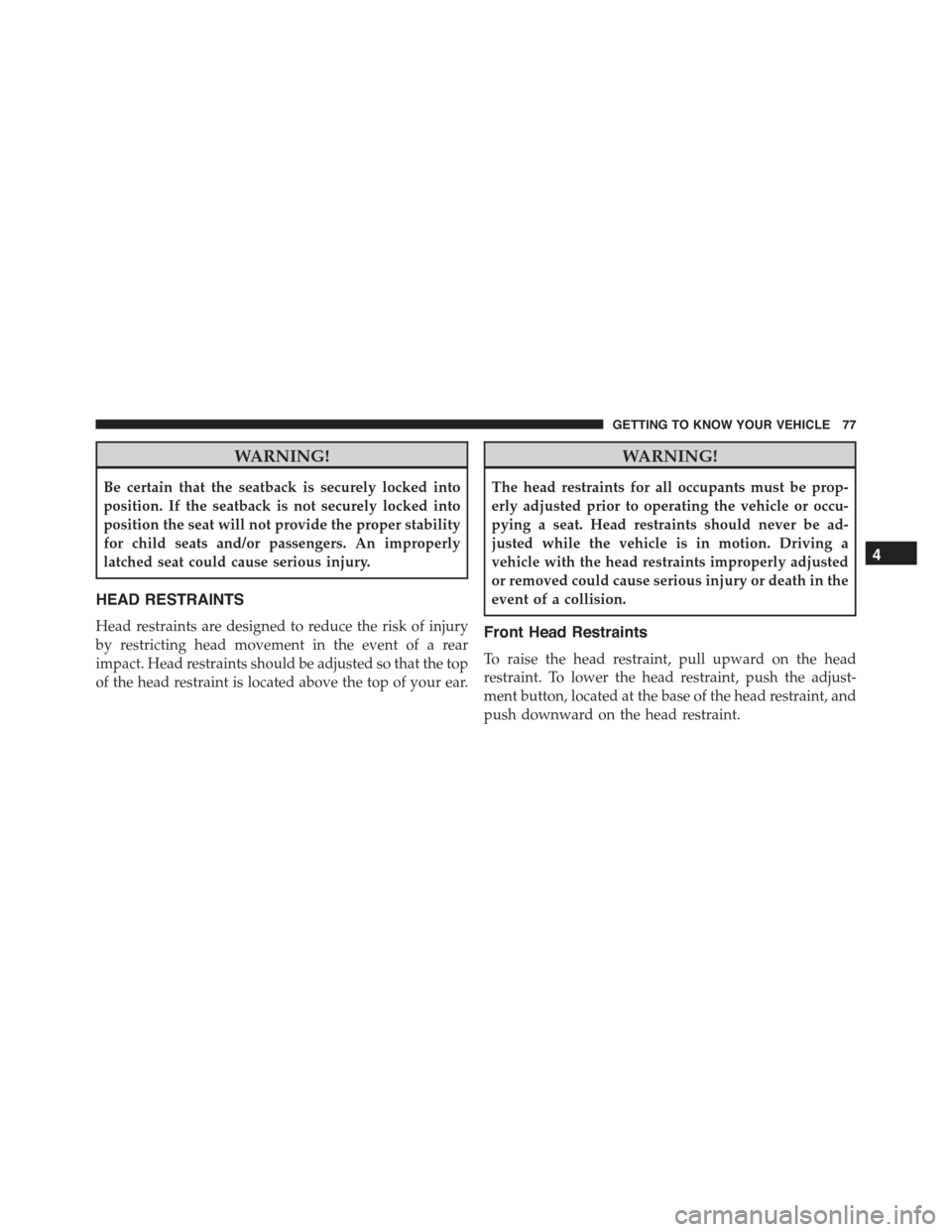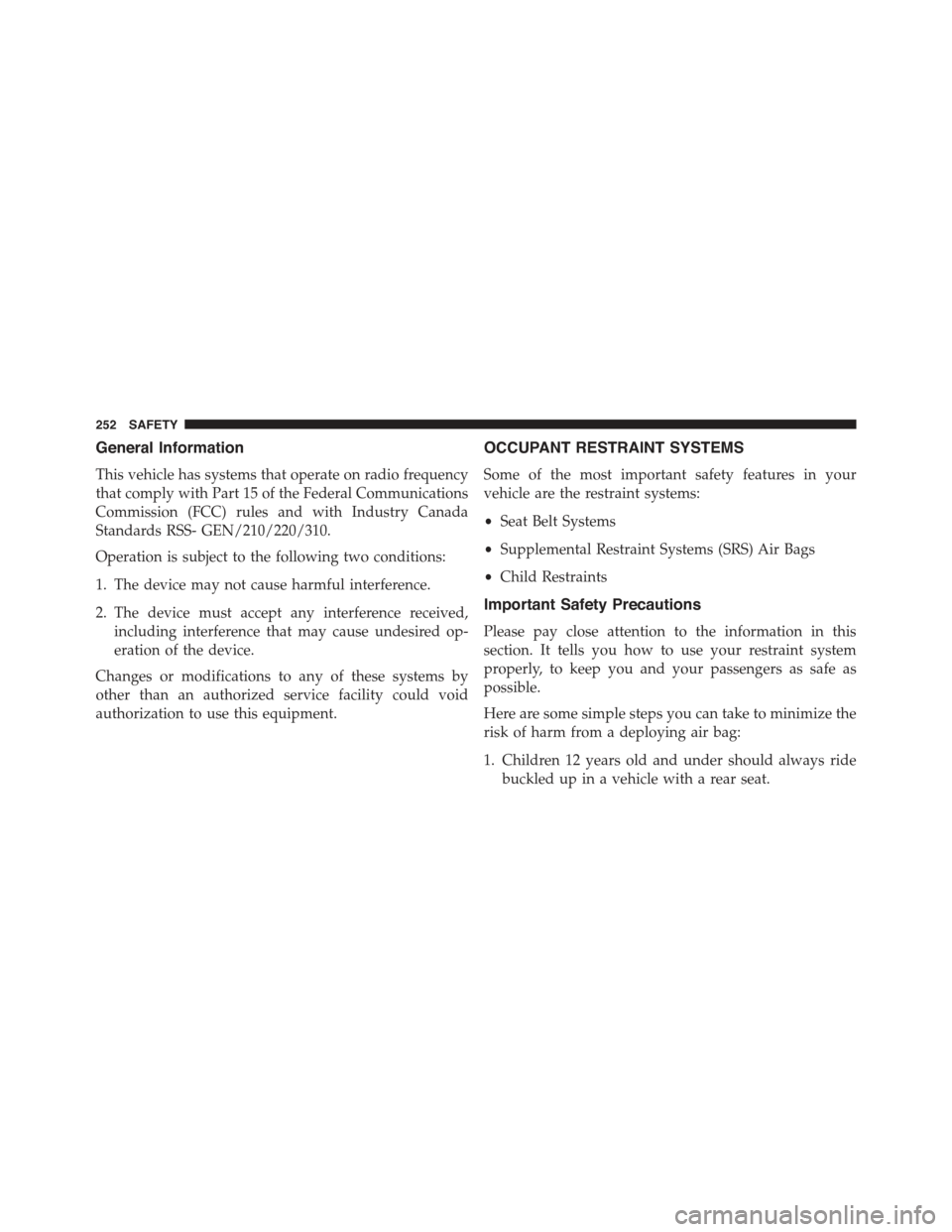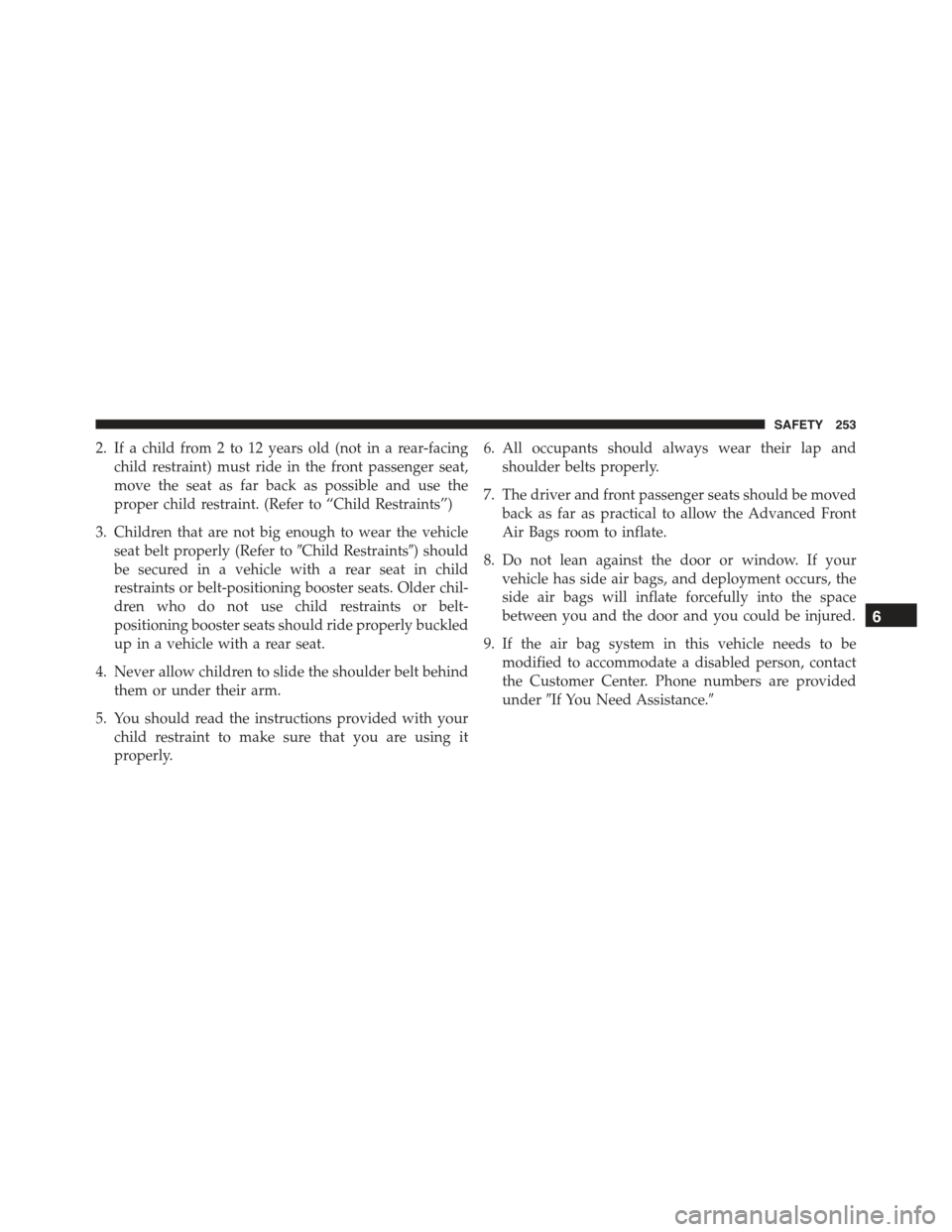Page 30 of 678

▫Disabling............................53
!DOORS..............................53
▫Manual Door Locks.....................53
▫Power Door Locks......................55
▫Keyless Enter-N-Go™...................56
▫Child Locks..........................64
!SEATS . . . . . . . . . . . . . . . . . . . . . . . . . . . . . . .65
▫Manual Front Seats.....................66
▫Power Seats — If Equipped...............68
▫Heated Seats — If Equipped...............69
▫Rear Seats............................71
!HEAD RESTRAINTS.....................77
▫Front Head Restraints...................77
▫Rear Head Restraints....................78
!TILT/TELESCOPING STEERING COLUMN....79
!HEATED STEERING WHEEL — IF EQUIPPED . .80
!REAR-VIEW MIRRORS...................81
▫Inside Day/Night Mirror................81
▫Dimming Mirror — If Equipped............82
▫Outside Mirrors.......................83
▫Heated Mirrors — If Equipped............85
!BLIND SPOT MONITORING (BSM) — IF
EQUIPPED............................85
▫Rear Cross Path (RCP)..................91
▫Mode Of Operation.....................93
▫Blind Spot Monitoring Fault Warnings.......94
28 GETTING TO KNOW YOUR VEHICLE
Page 47 of 678

WARNING!(Continued)
•Do not leave children or animals inside parked
vehicles in hot weather. Interior heat build-up may
cause serious injury or death.
CAUTION!
An unlocked car is an invitation to thieves. Always
remove key from the ignition and lock all doors
when leaving the vehicle unattended.
NOTE:For further information, refer to#Starting the
Engine,#in#Starting And Operating.#
REMOTE STARTING SYSTEM — IF EQUIPPED
This system uses the Remote Keyless Entry
(RKE) transmitter to start the engine conve-
niently from outside the vehicle while still
maintaining security. The system has a range of
at least 300 ft (91 m).
The Remote Starting System also activates the Climate
Control and (if equipped) the optional heated seats and
optional heated steering wheel depending on tempera-
tures outside and inside the car.
NOTE:
•The vehicle must be equipped with an automatic
transmission to be equipped with Remote Start.
•Obstructions between the vehicle and RKE transmitter
may reduce this range.
4
GETTING TO KNOW YOUR VEHICLE 45
Page 66 of 678
Child Locks
To provide a safer environment for small children riding
in the rear seats, the rear doors are equipped with a
Child-Protection Door Lock system.
To use the system, open each rear door, use a flat blade
screwdriver (or ignition key) and rotate the dial to the
LOCK or UNLOCK position. When the system on a door
is engaged, that door can only be opened by using the
outside door handle even if the inside door lock is in the
unlocked position.
Child-Protection Door Lock Location
64 GETTING TO KNOW YOUR VEHICLE
Page 67 of 678
NOTE:
•When the child lock system is engaged, the door can
only be opened by using the outside door handle even
though the inside door lock is in the unlocked position.
•After disengaging the Child-Protection Door Lock
system, always test the door from the inside to make
certain it is in the desired position.
•After engaging the Child-Protection Door Lock sys-
tem, always test the door from the inside to make
certain it is in the desired position.
•For emergency exit with the system engaged, rotate
the lock button to the unlocked position, roll down the
window, and open the door with the outside door
handle.
WARNING!
Avoid trapping anyone in a vehicle in a collision.
Remember that the rear doors can only be opened
from the outside when the Child-Protection locks are
engaged.
SEATS
Seats are a part of the Occupant Restraint System of the
vehicle.
4
GETTING TO KNOW YOUR VEHICLE 65
Page 79 of 678

WARNING!
Be certain that the seatback is securely locked into
position. If the seatback is not securely locked into
position the seat will not provide the proper stability
for child seats and/or passengers. An improperly
latched seat could cause serious injury.
HEAD RESTRAINTS
Head restraints are designed to reduce the risk of injury
by restricting head movement in the event of a rear
impact. Head restraints should be adjusted so that the top
of the head restraint is located above the top of your ear.
WARNING!
The head restraints for all occupants must be prop-
erly adjusted prior to operating the vehicle or occu-
pying a seat. Head restraints should never be ad-
justed while the vehicle is in motion. Driving a
vehicle with the head restraints improperly adjusted
or removed could cause serious injury or death in the
event of a collision.
Front Head Restraints
To raise the head restraint, pull upward on the head
restraint. To lower the head restraint, push the adjust-
ment button, located at the base of the head restraint, and
push downward on the head restraint.
4
GETTING TO KNOW YOUR VEHICLE 77
Page 224 of 678
▫Changing FCW And Active Braking Status. . . .248
▫FCW Limited Warning..................248
▫Service FCW Warning..................249
▫Precautions While Driving With FCW.......249
▫General Information...................252
!OCCUPANT RESTRAINT SYSTEMS.........252
▫Important Safety Precautions.............252
▫Seat Belt Systems.....................254
▫Supplemental Restraint System (SRS).......269
▫Child Restraints......................287
▫Transporting Pets.....................309
!SAFETY TIPS.........................309
▫Transporting Passengers.................309
▫Exhaust Gas.........................310
▫Safety Checks You Should Make Inside The
Vehicle.............................311
▫Periodic Safety Checks You Should Make Outside
The Vehicle.........................313
222 SAFETY
Page 254 of 678

General Information
This vehicle has systems that operate on radio frequency
that comply with Part 15 of the Federal Communications
Commission (FCC) rules and with Industry Canada
Standards RSS- GEN/210/220/310.
Operation is subject to the following two conditions:
1. The device may not cause harmful interference.
2. The device must accept any interference received,
including interference that may cause undesired op-
eration of the device.
Changes or modifications to any of these systems by
other than an authorized service facility could void
authorization to use this equipment.
OCCUPANT RESTRAINT SYSTEMS
Some of the most important safety features in your
vehicle are the restraint systems:
•Seat Belt Systems
•Supplemental Restraint Systems (SRS) Air Bags
•Child Restraints
Important Safety Precautions
Please pay close attention to the information in this
section. It tells you how to use your restraint system
properly, to keep you and your passengers as safe as
possible.
Here are some simple steps you can take to minimize the
risk of harm from a deploying air bag:
1. Children 12 years old and under should always ride
buckled up in a vehicle with a rear seat.
252 SAFETY
Page 255 of 678

2. If a child from 2 to 12 years old (not in a rear-facing
child restraint) must ride in the front passenger seat,
move the seat as far back as possible and use the
proper child restraint. (Refer to “Child Restraints”)
3. Children that are not big enough to wear the vehicle
seat belt properly (Refer to#Child Restraints#) should
be secured in a vehicle with a rear seat in child
restraints or belt-positioning booster seats. Older chil-
dren who do not use child restraints or belt-
positioning booster seats should ride properly buckled
up in a vehicle with a rear seat.
4. Never allow children to slide the shoulder belt behind
them or under their arm.
5. You should read the instructions provided with your
child restraint to make sure that you are using it
properly.
6. All occupants should always wear their lap and
shoulder belts properly.
7. The driver and front passenger seats should be moved
back as far as practical to allow the Advanced Front
Air Bags room to inflate.
8. Do not lean against the door or window. If your
vehicle has side air bags, and deployment occurs, the
side air bags will inflate forcefully into the space
between you and the door and you could be injured.
9. If the air bag system in this vehicle needs to be
modified to accommodate a disabled person, contact
the Customer Center. Phone numbers are provided
under#If You Need Assistance.#
6
SAFETY 253